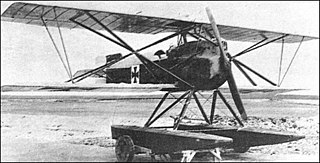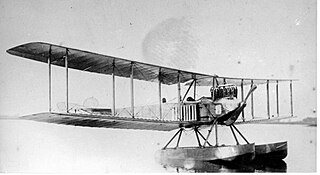
The Rumpler 6B was a German single-engine floatplane fighter with a biplane wing structure, designed and built by Rumpler Flugzeugwerke, in Berlin Johannisthal and introduced in 1916.

The Hansa-Brandenburg KDW was a German single-engine, single-seat, fighter floatplane of World War I. The KDW – Kampf Doppeldecker, Wasser – was adapted from the Hansa-Brandenburg D.I landplane to provide coastal defence over the North Sea.

The Hansa-Brandenburg W.12 was a German biplane fighter floatplane of World War I. It was a development of Ernst Heinkel's previous KDW, adding a rear cockpit for an observer/gunner, and had an unusual inverted tailfin/rudder in order to give an uninterrupted field of fire.

Hansa-Brandenburg W.33 was a German two-seat, single-engined low-wing monoplane floatplane, which had been developed by Hansa und Brandenburgische Flugzeugwerke during World War I as a higher powered enlargement of the similar Hansa-Brandenburg W.29 and despite the increase in size the two types are very difficult to differentiate. Although the W.33 was built in small numbers during the war many license built versions were built after World War I.

The Hansa-Brandenburg W.19 was a German fighter-reconnaissance aircraft of World War I. It was a single-engined two-seat biplane floatplane, and was a larger development of the successful W.12. It served with the Kaiserliche Marine during 1918.

The Hansa-Brandenburg CC was a single-seat German fighter flying boat of World War I. It was used by both the Kaiserliche Marine and the Austro-Hungarian Navy.

The Lohner L was a reconnaissance flying boat produced in Austria-Hungary during World War I. It was a two-bay biplane of typical configuration for the flying boats of the day, with its pusher engine mounted on struts in the interplane gap. The pilot and observer sat side by side in an open cockpit, and both the upper and lower sets of wings featured sweepback.
The Hansa-Brandenburg GW was a floatplane torpedo bomber produced in Germany during World War I for the Imperial German Navy. In configuration, it was similar to the Hansa-Brandenburg G.I land-based bomber, but the GW was substantially larger and heavier. Like the G.I, it was a conventional three-bay biplane design with staggered wings with the lower wing of slightly greater span than the upper. The undercarriage consisted of twin floats, each mounted on a separate truss structure, leaving space between them for a single torpedo to be dropped from the underside of the fuselage. The metal trusses that had attached the engines to the sides of the G.I's fuselage were not present in this design, with the engine nacelles carried on struts in the interplane gap.

The Hansa-Brandenburg W was a reconnaissance floatplane produced in Germany in 1914 to equip the Imperial German Navy. Similar in general layout to the Hansa-Brandenburg B.I landplane, the W was a conventional three-bay biplane with unstaggered wings of equal span. The pilot and observer sat in tandem, open cockpits, and the undercarriage consisted of twin pontoons.

The Hansa-Brandenburg W.11 was a fighter floatplane built in Germany in 1917 as a more powerful version of the KDW. Similar in general configuration to its predecessor, the W.11 shared the same unusual interplane strut arrangement, and featured fins above and below the fuselage. Only three examples were built.

The Hansa-Brandenburg W.13 was a flying boat bomber developed in Germany in 1917 and used by the Austro-Hungarian Navy during World War I.

The Hansa Brandenburg W.27 and W.32 were prototype fighter floatplanes developed in parallel in Germany during World War I. They were developments of and intended replacements for the W.12 then in service and differed from each other principally in the choice of powerplant, the W.27 with a Benz Bz.IIIb and the W.32 with the same Mercedes D.III that the original W.12 used.

The Hansa-Brandenburg W.20 was a German submarine-launched reconnaissance flying boat of the World War I era, designed and built by Hansa-Brandenburg.

The Zeppelin-Lindau CS.I was a German single-engined reconnaissance seaplane with a low-wing monoplane layout.
The Hansa-Brandenburg W.16 was a floatplane fighter built in Germany during World War I for the Imperial German Navy.
Hansa-Brandenburg W.34 was a prototype German two-seat, single-engined floatplane, which had been designed by Hansa und Brandenburgische Flugzeugwerke during World War I.

The Hansa-Brandenburg W.18 was a single-seat German fighter flying boat of World War I. It was used by both the Kaiserliche Marine and the Austro-Hungarian Navy.
The Hansa-Brandenburg W.25 was a German floatplane fighter of the World War I era, designed and built by Hansa-Brandenburg.
The Hansa-Brandenburg W.17 was a German flying boat fighter of the World War I era, designed and built by Hansa-Brandenburg.
The Hansa-Brandenburg W.23 was a German flying-boat fighter of World War I.
















